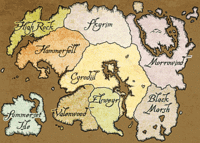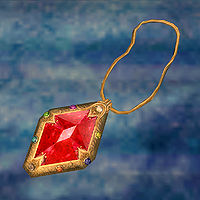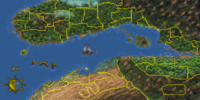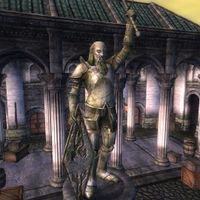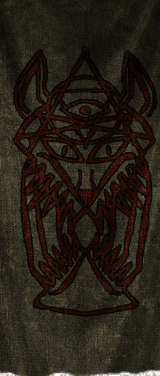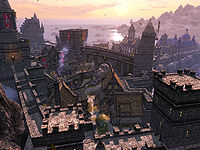Lore:War of the Red Diamond
The War of the Red Diamond was a civil war primarily fought between 3E 121 and 3E 127,[1][2][3][Note 1] with further conflict lasting another ten years until 3E 137.[2][3] It was a war of succession that nearly tore the Empire apart[4] and eliminated prospects for a unified nation for several years.[5] A leading instigator of the conflict was Potema, the Wolf-Queen of Solitude, who sought control either by regency through her son, Emperor Uriel III, or with herself as Empress.[2][6]
In the war's first year, it was a battle against the Empire under Kintyra II, and after Uriel III's ascension, it was remnants of that previous reign led by the brothers Cephorus I and Magnus. It is named after the Red Diamond, a symbol of the Septim Dynasty and the Cyrodilic Emperors.[2]
History[edit]
Prelude[edit]
"The girl called Kintyra is popularly believed to be the daughter of Magna and the Captain of the Guard. It may be that she is the daughter of Magna and the boy who cleans the cistern. We can never know for certain. Not as certainly as we can know the lineage of my son, Uriel. The last of the Septim Dynasty."
—Potema's infamous speech, as recounted in the Biography of the Wolf Queen by Katar Eriphanes
Emperor Pelagius II passed away in 3E 98 during the North Winds Prayer festival, a bad omen for the Empire. After the funeral service, his first child, Antiochus, was crowned Emperor.[7] Not long after Pelagius' death, in just the next springtide, King Mantiarco of Solitude died. His wife Potema assumed control of the kingdom with their son Uriel Mantiarco as the heir apparent. As the Regent Queen, Potema hosted many emissaries and royalty from across Skyrim and even further out from High Rock and Morrowind. Through these meetings, she sowed contempt for the Empire.[8][9] The Wolf Queen historical-fiction even hints that it was Potema who convinced King Orgnum of Pyandonea to start his war against the Empire.[9]
Though Antiochus proved an effective leader, little was done to heal old wounds in the northern kingdoms after centuries of neglect. Antiochus himself passed away in 3E 120, and his daughter Kintyra was named his successor shortly after. At the half funeral, half coronation, Potema was quick to challenge Kintyra's claim, and gave her infamous speech to the Elder Council with her family present. She began with her appraisal of the late Antiochus and his victory over Pyandonea, but without a moment to waste, she talked lowly of the Empress, questioned the identity of Kintyra's father, and uplifted the legitimacy of her son, Uriel Mantiarco.[8][10]
The Elder Council ignored Potema and placed Kintyra on the Ruby Throne as Kintyra II.[8][10] Potema was brought before Kintyra the subsequent evening and banished from the Imperial Court and from Kintyra's coronation in two days' time,[10] on the 3rd of First Seed. Potema and Uriel angrily returned to Solitude where she immediately planned her rebellion. Supported by the many allies she had acquired over the years, the War of the Red Diamond commenced.[8][11]
The Empire Divided[edit]
The war began in 3E 121 with attacks across Potema's allied provinces, leaving Tamriel in turmoil.[Note 2] Potema had all of Skyrim by her side as well as the noble houses of northern Morrowind and High Rock.[2][11] Other states like Ebonheart also supported her, albeit this secret in particular was poorly kept.[12]
The war began with two major attacks, the first on the Iliac Bay and the second in eastern Morrowind.[13] The Imperial Army strained their resources while Potema's forces incited riots and insurrections across northern High Rock and Skyrim.[11]
In the autumn, the loyal Duke of Glenpoint, Mentin, sent an urgent request for reinforcements. Kintyra II felt inspired to lead the army herself and made her way northwest to fight the Wolf Queen personally. Along the way, she and her forces nearly walked into an ambush in the Dragontail Mountains,[11] and experienced an unexpected blizzard in temperate Dwynnen. On the night she stayed in Glenpoint Castle, Kintyra II learned that a letter penned under her name had been sent to the Imperial City requesting a second army to come and support her. This was a ploy conceived by Potema, who coerced the Duke of Glenpoint to be her accomplice. Her forces ambushed this second army in the Dragontail Mountains, leaving the Imperial City underhanded. With her original army defeated, Kintyra II was imprisoned in Glenpoint's dungeons, where she was later executed.[11]
Meanwhile, Uriel's second attack in eastern Morrowind commenced. It targeted several Imperial garrisons on the coastal islands, and Kintyra's consort was killed in the battle. As the Elder Council was busy suppressing the fighting up north, Uriel marched into an ill-defended Imperial City. The siege of the city lasted barely a fortnight, and Uriel took the throne that same evening under the name Uriel Septim III.[13] A statue was built in his honor in the Market District, where it remained for the rest of the Third Era.[14]:347
Even though the war wholly took place in northern Tamriel, and places like Valenwood completely avoided it,[15] the provinces of the Empire at large were nonetheless divided in their allegiances. Nobles across Black Marsh, Elsweyr, Hammerfell, the Summerset Isles, and Valenwood were mixed, though most kings supported Cephorus and Magnus.[2] Even the Blades were divided over the legitimacy of the throne.[UOL 1] The Knights of the Nine, who famously sought out the lost Crusader's Relics, mostly disbanded because of their differing loyalties in the war. Members of the order came from noble families on either side of the conflict, and while Sir Amiel Lannus did everything he could to keep them together, nothing stopped the knights from fighting. Sir Berich Vlindrel was the first to leave, and along with many of his friends, he joined Cephorus' side with both the greaves and sword of the Crusader at his disposal.[16][17]
The story of Kintyra II's death has since become one of the saddest tales in the Empire's history.[13] The exact date of her execution is not known for certain. Some sources claim it happened shortly after her imprisonment in 3E 121. In contrast, other sources are adamant she was kept alive for four more years until Cephorus re-conquered High Rock in 3E 125.[18] A consistent aspect among the differing accounts of her death is that it occurred on the 23rd morning of Frostfall.[1][19][20] The reaction to Kintyra II's demise was resounding. The local Bretons of Glenpoint and neighboring Glenumbra Moors felt abject horror and regret when they learned that their Empress had died in their home and from their own inaction. A witchhunt took place in the two regions until they cornered the perpetrator.[19] This day has since been memorialized as Broken Diamonds, a holiday where locals gather in an Imperial castle out in the wilderness to sing songs of mourning and solemnly pray for the Septim family's health and benevolence.[19][20] The circumstances of Kintyra's death were considered by some to be the end of the pure strain of Septim blood in the family.[13] Emperor Uriel III and the Wolf Queen were reviled for their crimes, and the Empress' death rallied many people against them.[18]
The Conflict[edit]
—Potema's speech at the Battle of Falconstar as quoted from The Wolf Queen by Waughin Jarth
The war was split between Uriel III and Potema's allied forces, and the combined armies of Cephorus and Magnus. Cephorus, as King of Gilane, led an army of Redguards and fought much of the war in western Tamriel, between High Rock and Hammerfell. Meanwhile, King Magnus of Lilmoth led an army of Argonians through Morrowind and later Skyrim.[18]
At that same time, Mournhold, a historical ally of the Empire, fought alongside the brothers against the Wolf Queen. Their king, Symmachus, won many battles throughout the war.[12] Although the brothers gained support after Kintyra's death, the Empress' presence in High Rock led to some of the bloodiest battles in the war taking place there. While the exact details are unknown, Potema and Uriel III's wrath came down on the Kingdom of Wayrest.[12][Note 3]
Cephorus was able to reconquer western High Rock by the summer of 3E 125 and eventually traveled south into Hammerfell.[18] The Dragontail Mountains became contentious at this point in the war because of their geographical advantages.[21] In the east, Magnus traveled throughout eastern Tamriel until he eventually reached Skyrim. Here, the war went back and forth so much that it lasted two more years. The Argonians fought exceptionally well in the summers but retreated south to regroup come winter.[18]
In the summer of 3E 127, both factions and their respective leaders eventually met each other on the battlefield. Cephorus engaged Uriel III at the Battle of Ichidag in the eponymous countryside of Hammerfell while Magnus and Potema met in the Battle of Falconstar somewhere in Skyrim. The details of the Battle of Ichidag are unknown, but in the end, Cephorus defeated and captured the Emperor and took him back home to Gilane to be put on trial. Potema received this news just as she began her attack. As her soldiers attacked Magnus at Kogmenthist Castle, Uriel III's caravan was ransacked by an angry crowd and he died in the ensuing fires. This news reached Potema by the time she had won her battle.[18]
Post-Battle of Ichidag[edit]
Upon the Emperor's death, the King of Gilane was proclaimed Emperor of Tamriel as Cephorus Septim I.[2][18] Potema reacted with a terrifying fury.[8] Though there had been rumors of undead warriors in her service since the start of the war,[11] the death of her son and the rise of her brother led her to resort to the use of daedra and to the use of necromancers to resurrect fallen soldiers. Troops and kingdoms formerly loyal to Uriel III and Potema turned coat to the new Emperor, and in return they received new levels of autonomy and independence than ever before.[8][3]
Though Potema and the new Empire continued to fight for ten more years, Uriel III's death is agreed upon to mark the war's end. In time, Potema and the Kingdom of Solitude were left to fend for themselves.[3] From a nearby cave now known as Wolfskull Cave, she used necromantic rituals to create a reusable army[4] and mount countless attacks on her brothers. Solitude became a "land of death", where its people lived in fear and hiding while Potema, according to rumor, kept company with rotting skeleton chambermaids and vampire generals.[3]
The battlefront finally reached Solitude city-state in 3E 137 with the Siege of Solitude. It was a month-long bombardment of the Blue Palace, where Potema was holed up. It took weeks before life returned to the city-state.[3] The siege is noted for being the young Pelagius III's first battle at eighteen years old.[12] Potema succumbed to old age in her bedchamber before the siege ended, and her war of succession had finally come to an end. In her stead, the young Prince Thoriz Pelagius was named the titular ruler of Solitude with guidance from a royal council.[3] Sir Berich Vlindrel was another figure in the war who gained notoriety in its aftermath, especially after the Battle of Ichidag.[16]
It is unknown what Emperor Cephorus I did after the war, but his successor, his younger brother Magnus I, spent his short tenure dealing with the war's aftermath. Though kingdoms previously allied with the Wolf Queen were granted new freedoms for changing sides, Magnus I either punished these traitorous kings[2] or used diplomacy to restore relations, as seen with Ebonheart. On his orders, the Emperor arranged the marriage of his son, King Pelagius, and the heiress to Ebonheart's royal family, Katariah. Third Era scholars like Tsathenes believed one other reason was that her shrewdness as a diplomat and her remarkable beauty could effectively hide the growing eccentricities of Pelagius.[12]
Legacy[edit]
—A Priest of Arkay on Potema[6]
Looking back throughout the years, the War of the Red Diamond was a tumultuous time in the Empire that was still felt years later at the turn of the Third Era.[5] The vision of a united Empire seemed all but lost,[5] with the closest it had ever been coming years later between Pelagius IV and Uriel VII's reign.[22]
While Uriel III was scorned at the time by public perception, Potema is considered one of the few historical figures that were "unambiguously evil".[8] She had also cemented herself as one of the most powerful necromancers in recorded history,[6] and one of the deadliest people to come from Skyrim.[4] Some even consider her war to have been the near collapse of the Empire.[6] Though Wolfskull Cave had long been abandoned to the wilderness, locals from Solitude and nearby Dragon Bridge were convinced that the cave was haunted around 4E 201.[4]
The war's political consequences have also persisted. Underground movements such as the Hörme in Skyrim were established under the continued belief that Potema and Uriel III were the last descendants of Tiber Septim. They went against Imperial interests in the province and orchestrated raids on places like Whiterun Hold.[23] A coven of necromancers attempted to resurrected Potema in 4E 201 and succeeded in bringing her spirit form back to the mortal world. Her spirit was, however, defeated by an adventurer, and her remains were sanctified by a priest of Arkay.[24][25]
Stories of the Wolf Queen inspired many writers to create works detailing her life and history. Katar Eriphanes wrote the aptly named Biography of the Wolf Queen, which detailed her life from childhood to death in one book.[8] The famous author Waughin Jarth, also inspired greatly by her life and ambitions, wrote The Wolf Queen, a well-regarded piece of historical-fiction that provides significantly more detail and spans eight volumes. He reportedly used hundreds of contemporary narratives to create the story but intentionally skimped on specific details not related to the main subject.[26][UOL 2]
Major Battles[edit]
- Battle of Ichidag, 3E 127. Forces under Cephorus defeated Uriel III, who was killed in the aftermath of the battle. Cephorus was crowned Emperor.[2][12]
- Battle of Falconstar, 3E 127. Contemporaneously with the Battle of Ichidag, the forces of Queen Potema fought the forces of Magnus Septim in Skyrim. Upon learning of her son's capture, Potema flew into a rage and led a successful assault on Magnus' weakest flank, causing Magnus and his army to retreat. Word of Uriel III's death reached them soon after.
- Siege of Solitude, 3E 137. The Wolf Queen, Potema of Solitude, was finally defeated after a month-long siege of her castle. Although not a full part of the War of the Red Diamond, the siege is best viewed as a postscript, as with the death of the entire royal family except Cephorus I, Magnus, Pelagius and Jolethe, all possible argument over the line of succession ended.[3]
Notes[edit]
References[edit]
- ^ a b The Third Era Timeline — Jaspus Ignateous
- ^ a b c d e f g h i Brief History of the Empire v 2 — Stronach k'Thojj III
- ^ a b c d e f g h i The Wolf Queen, v8 — Waughin Jarth
- ^ a b c d Falk Firebeard's dialogue in Skyrim
- ^ a b c Pocket Guide to the Empire, 3rd Edition: All the Eras of Man, A Comprehensive History of our History — Imperial Geographical Society, 3E 432
- ^ a b c d Styrr's dialogue in Skyrim
- ^ The Wolf Queen, v3 — Waughin Jarth
- ^ a b c d e f g h Biography of the Wolf Queen — Katar Eriphanes
- ^ a b The Wolf Queen, v4 — Waughin Jarth
- ^ a b c The Wolf Queen, v5 — Waughin Jarth
- ^ a b c d e f The Wolf Queen, v6 — Waughin Jarth
- ^ a b c d e f The Madness of Pelagius — Tsathenes
- ^ a b c d Brief History of the Empire v 1 — Stronach k'Thojj III
- ^ The Elder Scrolls IV: Oblivion Official Game Guide — Peter Olafson
- ^ Pocket Guide to the Empire, 3rd Edition: The Wilds Remain: Valenwood — Imperial Geographical Society, 3E 432
- ^ a b The Knights of the Nine — Karoline of Solitude
- ^ Sir Amiel's dialogue in Oblivion: Knights of the Nine
- ^ a b c d e f g The Wolf Queen, v7 — Waughin Jarth
- ^ a b c Broken Diamonds — Ryston Baylor
- ^ a b Broken Diamonds holiday description in Daggerfall
- ^ Dragontail Savior card lore entry for Legends
- ^ Brief History of the Empire v 4 — Stronach k'Thojj III
- ^ Pocket Guide to the Empire, 3rd Edition: The Throat of the World: Skyrim — Imperial Geographical Society, 3E 432
- ^ The Man Who Cried Wolf quest in Skyrim
- ^ The Wolf Queen Awakened quest in Skyrim
- ^ Father Of The Niben — Florin Jaliil
Note: The following references are considered to be unofficial sources. They are included to round off this article and may not be authoritative or conclusive.
|
|||||||||||||||||
